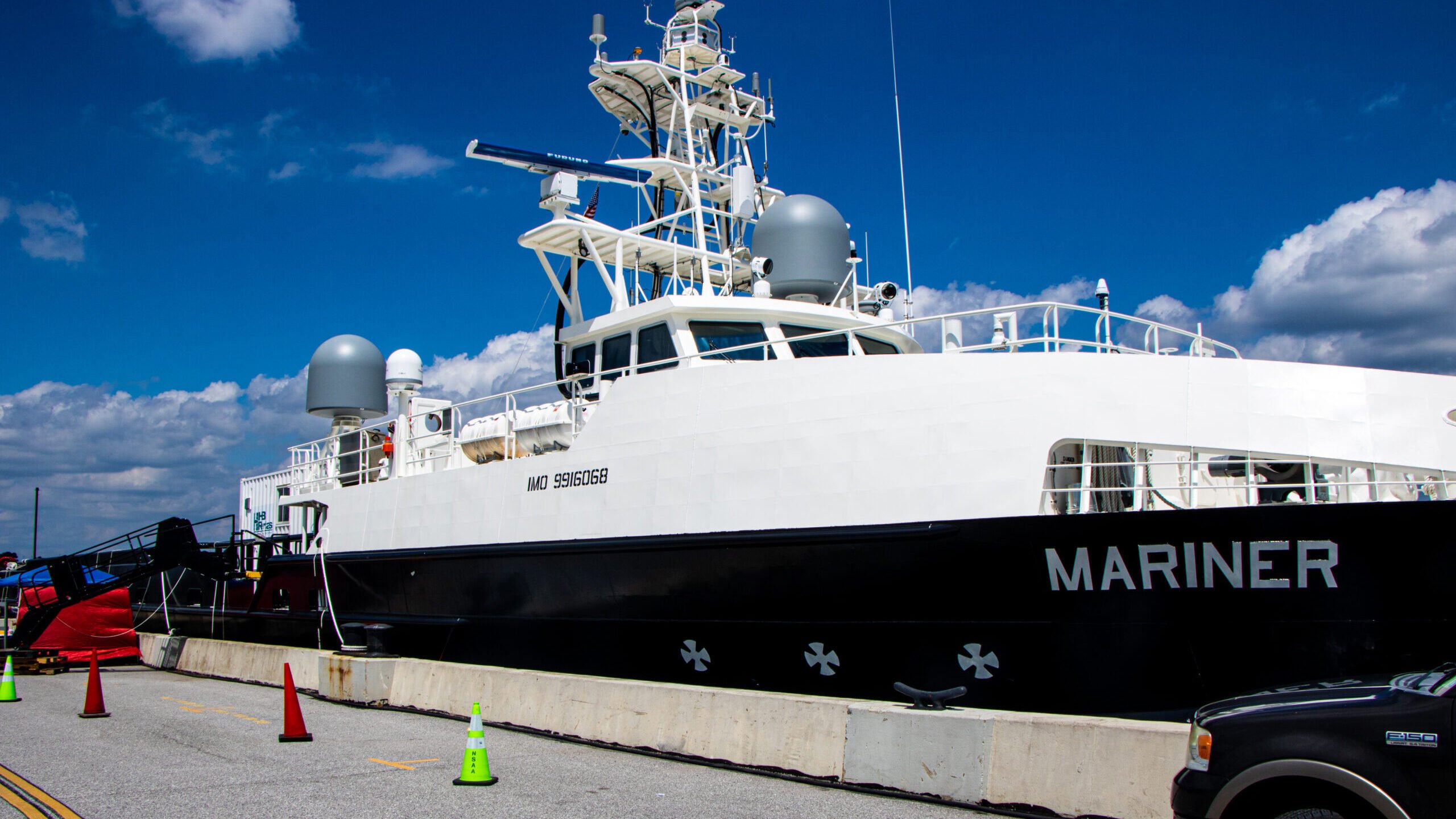
The USV Mariner, a US Navy research and development vessel, docked at the United States Naval Academy where it was christened on Aug. 23, 2022. (Justin Katz/Breaking Defense)
WASHINGTON — The US Navy is considering the establishment of a “Disruptive Capabilities Office” focused on rapidly fielding existing technologies to address operational problems, according to sources as well as a draft document obtained by Breaking Defense.
The final details of this new office are still in flux and plans could change pending approvals from Navy Secretary Carlos Del Toro and acting Chief of Naval Operations Adm. Lisa Franchetti. But a draft charter, dated for late June 2023 and circulated this summer at an industry event, stated the DCO would be a “unique office” capable of “rapidly [solving] emerging operational problems with a broad aperture unconstrained by legacy processes.”
Further, if the Navy’s top officials sign the new office into life, it could trigger the end of the Unmanned Task Force, established by former CNO Adm. Michael Gilday in September 2021. “The DCO will leverage the UTF’s lessons learned, best practices and processes, and incorporate key UTF personnel,” according to the document. “Upon standup of the DCO, the UTF will be disestablished.”
Capt. Patrick Evans, a spokesman for Del Toro, told Breaking Defense today that, “it would be premature to comment on any internal deliberations or pre-decisional matters.” A spokeswoman for Franchetti declined to comment.
A source familiar with the discussions told Breaking Defense that one of the key issues the DCO would aim to resolve is the discrepancy between funding for systems as opposed to fielding and operations.
In the Navy’s current structure, funding for a given piece of technology is provided by one of several offices the service calls “the high nines,” a group of admirals and one Marine Corps general who advise the chief of naval operations on the requirements — and by extension the funding — for various ships, planes and other technologies. Their nickname comes from their offices being internally labeled as N95, N96, N97, etc.
But that funding doesn’t always lead to getting systems into the hands of warfighters, where the services can flesh out how the new tech can solve an operational problem. With this new office in place, the “high nines” would still fund — or in Navy lingo, be the “resource sponsors” for — various unmanned systems and other technologies, but the DCO would have the money and authority to see those same systems sent to the fleet for operations, according to the source.
Bringing ready tech into the fleet quickly was a focus for Gilday, who in his time as the Navy’s top officer made pushes to see the service use unmanned systems more widely, first for experimentation by Task Force 59, based out of Bahrain in US 5th Fleet, and more recently in operations by US 4th Fleet in South America.
And that same focus has seemingly caught the interest of Deputy Defense Secretary Kathleen Hicks, who earlier this week revealed new plans to mass produce autonomous systems through a program dubbed “Replicator.” Although cagey on the specifics, Hicks echoed the themes of the Navy’s efforts into unmanned: Find things that work, put them to work and don’t waste time doing it.
“To be clear, America still benefits from platforms that are large, exquisite, expensive, and few. But Replicator will galvanize progress in the too-slow shift of US military innovation to leverage platforms that are small, smart, cheap, and many,” she said Monday at an event in Washington, DC, organized by the National Defense Industrial Association.
Separately, the Hudson Institute on Friday published its own research into what fundamental changes the Defense Department needs to make in order to produce unmanned systems at scale.
The report, titled “Unalone and Unafraid: A Plan For Integrating Uncrewed and other Emerging Technologies into US Military Forces,” was authored by Hudson fellows Bryan Clark, a former special assistant to the CNO, and Dan Patt.
“Uncrewed systems can enable scale by foregoing robust self-defense and focusing on a narrow set of functions to lower their cost and complexity,” according to the new report. “These limitations will require that uncrewed systems be combined with other uncrewed systems and crewed platforms in systems of systems (SoS), which could exacerbate the US military’s long-standing struggles to integrate forces between and within each service branch.”
To achieve this, Hudson recommended the Pentagon formalize the process across the services to identify, buy and test out useful unmanned systems as well as establish an “innovation office” capable of funding and validating requirements across the branches. Hudson also recommended that program executive offices, the acquisition directorates empowered to develop and purchase warfighting technologies, each install program managers responsible for “the development and maintenance of [system of systems] software environments.
“In an environment where dominance is no longer a given, the US military needs to return to operational innovation,” the report concludes. “Accelerating and realizing the benefits of uncrewed systems will require better orchestration and execution of these activities to solve today’s operational problems. If the Navy and
DoD fail to do so, they may miss their best opportunity to gain an enduring advantage against peer opponents like China.”
"creation" - Google News
August 30, 2023 at 11:08PM
https://ift.tt/nmwPSRl
EXCLUSIVE: Navy weighs creation of ‘Disruptive Capabilities’ office to rapidly field tech to fleet - Breaking Defense
"creation" - Google News
https://ift.tt/EvJtTOI
https://ift.tt/MNiJ7ba
Bagikan Berita Ini














0 Response to "EXCLUSIVE: Navy weighs creation of ‘Disruptive Capabilities’ office to rapidly field tech to fleet - Breaking Defense"
Post a Comment